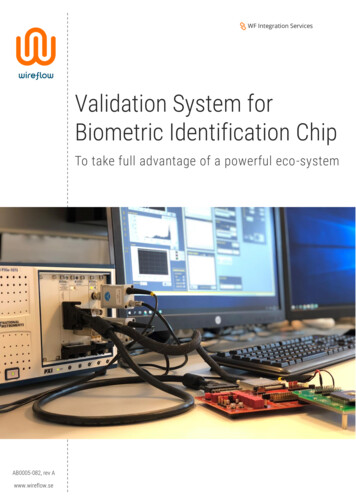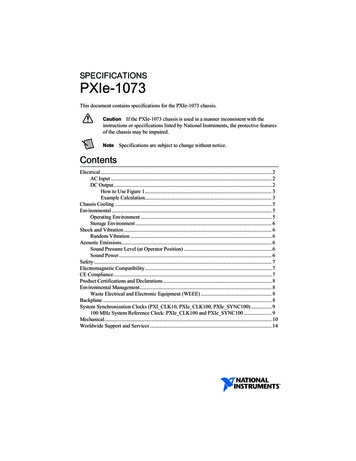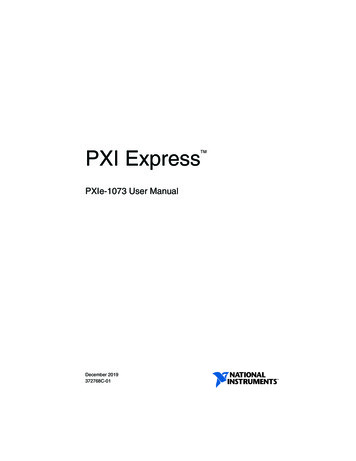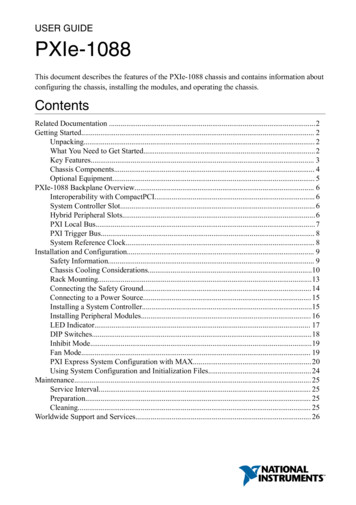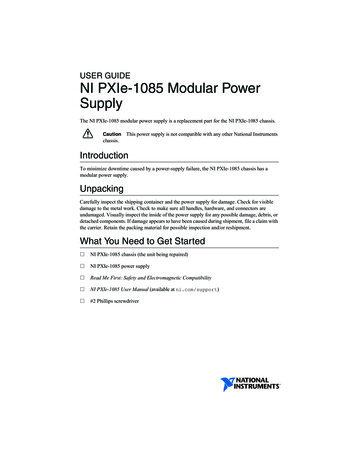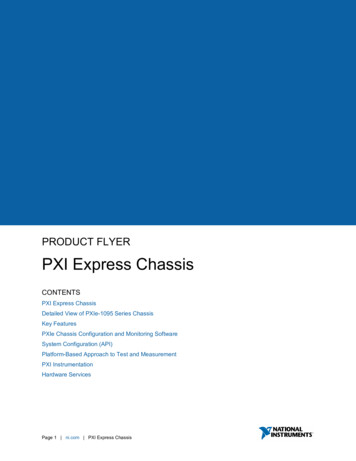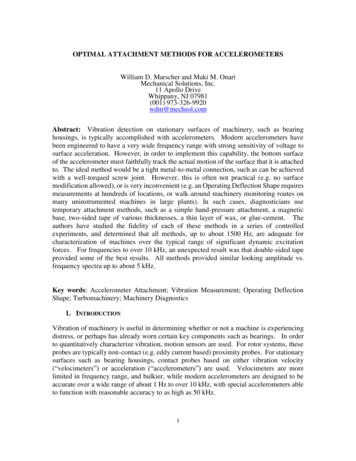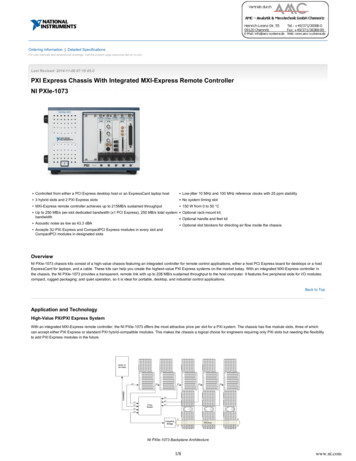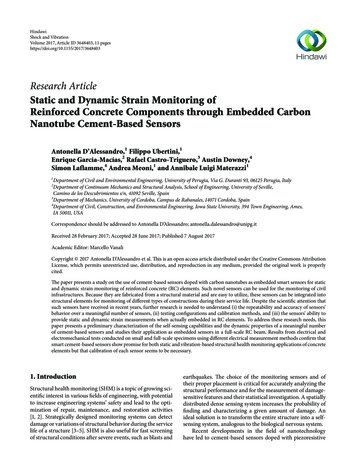
Transcription
USER GUIDEPXIe-1083This document describes the features of the PXIe-1083 chassis and contains information aboutconfiguring the chassis, installing the modules, and operating the chassis.ContentsRelated Documentation .2Getting Started. 2Unpacking. 2What You Need to Get Started.2Key Features. 3Chassis Components. 4Optional Equipment. 5PXIe-1083 Backplane Overview. 6Interoperability with CompactPCI. 6MXI Interface.6Basic MXI-Express Thunderbolt Systems. 6Thunderbolt Bus Extension.7Backwards Compatibility.7Hybrid Peripheral Slots. 7PXI Local Bus. 8PXI Trigger Bus. 9System Reference Clock. 9Installation and Configuration. 10Safety Information. 10Chassis Cooling Considerations.11Rack Mounting.14Connecting the Safety Ground. 15Connecting to a Power Source. 15Cabling. 16Powering On/Off the MXI-Express Thunderbolt System.16Installing Peripheral Modules. 17LED Indicators. 18DIP Switches.19Inhibit Mode.20Fan Mode. 21PXI Express System Configuration with MAX. 21Using System Configuration and Initialization Files. 25
Maintenance. 25Service Interval. 25Preparation. 25Cleaning. 26Worldwide Support and Services. 26Related DocumentationThe following documents contain information that you might find helpful as you read thismanual: IEEE 1101.1-1991, IEEE Standard for Mechanical Core Specifications forMicrocomputers Using IEC 603-2 Connectors IEEE 1101.10, IEEE Standard for Additional Mechanical Specifications forMicrocomputers Using IEEE 1101.1 Equipment Practice PICMG EXP.0 R1.0 CompactPCI Express Specification, PCI Industrial ComputersManufacturers Group PCI Express Base Specification, Revision 2.0, PCI Special Interest Group PXI-5 PXI Express Hardware Specification, Revision 2.0, PXI Systems AllianceGetting StartedUnpackingCarefully inspect the shipping container and the chassis for damage. Check for visible damageto the metal work. Check to make sure all handles, hardware, and switches are undamaged.Inspect the inner chassis for any possible damage, debris, or detached components. If damageappears to have been caused during shipment, file a claim with the carrier. Retain the packingmaterial for possible inspection and/or reshipment.What You Need to Get StartedThe PXIe-1083 chassis kit contains the following items: PXIe-1083 chassis Filler panels PXIe-1083 Safety, Environmental, and Regulatory Information Read Me First: Safety and Electromagnetic Compatibility Software media with PXI Platform Services 20.0 or newer Chassis number labelsNote You will also need an AC power cable, sold separately. Refer to the followingtable for more information about AC power cables.2 ni.com PXIe-1083 User Guide
Table 1. AC Power CablesPower CableReference StandardsStandard 120 V (USA)ANSI C73.11/NEMA 5-15-PSwitzerland 220 VSEV 6534-2Australia 240 VAS C112Universal Euro 230 VCEE (7), II, IV, VIIUnited Kingdom 230 VBS 1363Japan 100 VJIS 8303If you are missing any of the items, or if you have the incorrect AC power cable, contact NI.Key FeaturesThe PXIe-1083 chassis combines a high-performance 5-slot PXI Express backplane with apower supply and a structural design that has been optimized for maximum usability in a widerange of applications. The PXIe-1083 chassis fully complies with the PXI-5 PXI ExpressHardware Specification.The key features of the PXIe-1083 chassis include the following:High Performance for Instrumentation Requirements Two integrated Thunderbolt 3 MXI-Express portsUp to 500 MB/s (single direction) per PXI Express slot dedicated bandwidth (x1 Gen-2PCI Express)58 W per slot cooling meets increased PXI Express cooling requirements; refer to thePXIe-1083 Specifications for more detailsLow-jitter internal 10 MHz reference clock for PXI/PXI Express slots with 25 ppmstabilityLow-jitter internal 100 MHz reference clock for PXI Express slots with 25 ppmstabilityQuiet operation for 0 C to 30 C at 33.7 dBAVariable speed fan controller optimizes cooling and acoustic emissionsComplies with PXI and CompactPCI specificationsHigh Reliability 0 C to 50 C temperature rangePower supply, temperature, and fan monitoringField replaceable fansPXIe-1083 User Guide National Instruments 3
Optional Features Front and rear rack-mount kitsEMC filler panelsSlot blockers for improved cooling performanceFactory installation servicesHandle and rubber feet kitFan replacement kitChassis ComponentsThe following figures show key features of the PXIe-1083 chassis front and back panels.Figure 1. Front View of the PXIe-1083132LINK8PXIe-10837261.2.3.4.4 5Thunderbolt 3 MXI-Express PortsLINK LEDBackplane ConnectorsPXI Express Hybrid Peripheral Slots (5x)ni.com PXIe-1083 User GuideH3H4H5H6H45.6.7.8.Power Inhibit SwitchRemovable FeetStatus LEDPower Supply Airflow Intake Vents
Figure 2. Rear View of the PXIe-1083125100-240 VAC50/60 Hz6-3 A341. Rear Exhaust Vent2. Universal AC Input3. Power Supply Fan Exhaust4. Chassis Grounding Terminal5. Kensington SlotOptional EquipmentContact NI to order the following options for the PXIe-1083 chassis.EMC Filler PanelsEMC filler panel kits are available from NI.Slot BlockersPXI Slot Blocker kits are available from NI for improved thermal performance when all slotsare not used.Handle and Feet KitAn optional side handle and rubber feet kit is available from NI to provide portability.Rack Mount KitsRack mounting kits are available from NI that can accommodate a variety of rack depths.Replaceable Fan KitA fan kit is available from NI.PXIe-1083 User Guide National Instruments 5
PXIe-1083 Backplane OverviewInteroperability with CompactPCIThe design of the PXIe-1083 provides you the flexibility to use the following devices in asingle PXI Express chassis: PXI Express compatible products CompactPCI Express compatible Type-2 peripheral products PXI peripheral products modified to fit in a hybrid slot Standard CompactPCI peripheral products modified to fit in a hybrid slotMXI InterfaceThe PXIe-1083 chassis has a built-in Intel Thunderbolt 3 interface accessible through twoThunderbolt 3 ports on the front of the chassis. This enables control of the PXIe-1083 from ahost PC that includes a Thunderbolt 3 port and is running a native (nonvirtualized) operatingsystem that supports Thunderbolt connectivity.Note The PXIe-1083 chassis does not include a slot 1; the Thunderbolt 3 portsreplace this slot.Thunderbolt technology is transparent to device drivers, so no additional software is neededfor CompactPCI Express-level support for PXI Express devices in connected chassis.Note For full PXI/PXI Express functionality such as chassis and controlleridentification, trigger routing, and slot detection, install the latest version of PXIPlatform Services. This software is included with your kit; you also can find it atni.com/downloads by searching for PXI Platform Services.The link between the PC and the chassis is a Thunderbolt 3 link. This link is a dual-simplexcommunication channel comprised of differentially driven signal pairs. The link can transmitat a rate of up to 40 Gbps in each direction simultaneously.Basic MXI-Express Thunderbolt SystemsThe simplest MXI-Express Thunderbolt system consists of a PC connected to a PXIe-1083 inthe controller slot of a PXI Express chassis, as shown in the following figure.6 ni.com PXIe-1083 User Guide
Figure 3. Example of a Basic MXI-Express Thunderbolt Link TopologyThunderbolt Bus ExtensionYou can daisy-chain from a PXIe-1083 controlled by a laptop to an additional Thunderbolt 3compatible device. The following figure shows how you can use a PXIe-1083 to connectmultiple Thunderbolt 3 compatible devices to a PC in a daisy-chain topology.Figure 4. Example of a Daisy-Chain Thunderbolt Link TopologyBackwards CompatibilityNI recommends connecting the PXIe-1083 to a Thunderbolt 3 port on the host PC using aThunderbolt 3 cable. Because Thunderbolt 3 is backwards-compatible with previousThunderbolt generations, it may be possible to use adapters to establish connections with hostPCs or devices with previous-generation Thunderbolt ports. Data throughput performance mayvary between Thunderbolt generations.Hybrid Peripheral SlotsThe chassis provides five (5) hybrid peripheral slots as defined by the PXI-5 PXI ExpressHardware Specification: slots 2 through 6. A hybrid peripheral slot can accept the followingperipheral modules: A PXI Express peripheral with x8, x4, or x1 PCI Express link through a switch to theThunderbolt 3 controller (and host PC). Each PXI Express peripheral slot can link up to aPXIe-1083 User Guide National Instruments 7
Gen-2 x1 PCI Express, providing a maximum nominal single-direction bandwidth of 500MB/s.A CompactPCI Express Type-2 Peripheral with x8, x4, or x1 PCI Express link to the hostPC through a PCI Express switch and Thunderbolt 3 controller.A hybrid-compatible PXI Peripheral module modified by replacing the J2 connector withan XJ4 connector installed in the upper eight rows of J2. Refer to the PXI ExpressSpecification for details. The PXI peripheral communicates through the backplane’s 32bit PCI bus.A CompactPCI 32-bit peripheral on the backplane’s 32-bit PCI bus. The hybrid peripheral slots provide full PXI Express functionality and 32-bit PXI functionalityexcept for PXI Local Bus. The hybrid peripheral slot connects to only PXI Local Bus 6 leftand right.Figure 5. PXIe-1083 PCI Express Backplane Diagram2H3H4H5H6HThunderbolt 3Controller(to Host)PCIe-PCIBridge32-bit, 33 MHz PCIPort 5 Port 1PCIe SwitchPort 12 Port 14Port 0Port 9 Port 7(Upstream)PXI Local BusThe PXI backplane local bus is a daisy-chained bus that connects each peripheral slot withadjacent peripheral slots to the left and right.The backplane routes PXI Local Bus 6 between adjacent PXI slots. The left local bus 6 fromslot 2 and right local bus 6 from slot 6 are not routed anywhere.The backplane routes PXI Local Bus between all slots. Local bus signals may range fromhigh-speed TTL signals to analog signals as high as 42 V.Initialization software uses the configuration information specific to each adjacent peripheralmodule to evaluate local bus compatibility.8 ni.com PXIe-1083 User Guide
PXI Trigger BusAll slots share eight PXI trigger lines. You can use these trigger lines in a variety of ways. Forexample, you can use triggers to synchronize the operation of several different PXI peripheralmodules. Modules can pass triggers to one another on the lines, allowing precisely timedresponses to asynchronous external events the system is monitoring or controlling.The PXI trigger lines from adjacent PXI trigger bus segments can be routed in either directionacross the PXI trigger bridges through buffers. This allows you to send trigger signals to, andreceive trigger signals from, every slot in the chassis. Static trigger routing (user-specified lineand directional assignments) can be configured through Measurement & Automation Explorer(MAX). Dynamic routing of triggers (automatic line assignments) is supported through certainNI drivers like NI-DAQmx.Note Although any trigger line may be routed in either direction, it cannot berouted in more than one direction at a time.Figure 6. PXI Trigger Bus Connectivity Diagram2H3H4H5PXI Trigger Bus #1H6HPXITriggerBridge #1System Reference ClockThe PXIe-1083 chassis supplies PXI CLK10, PXIe CLK100 and PXIe SYNC100 to everyperipheral slot with an independent driver for each signal.An independent buffer (having a source impedance matched to the backplane and a skew ofless than 250 ps between slots) drives PXI CLK10 to each peripheral slot. You can use thiscommon reference clock signal to synchronize multiple modules in a measurement or controlsystem.An independent buffer drives PXIe CLK100 to each peripheral slot. These clocks are matchedin skew to less than 100 ps. The differential pair must be terminated on the peripheral withLVPECL termination for the buffer to drive PXIe CLK100 so that when there is no peripheralor a peripheral that does not connect to PXIe CLK100, there is no clock being driven on thepair to that slot.An independent buffer drives PXIe SYNC100 to each peripheral slot. The differential pairmust be terminated on the peripheral with LVPECL termination for the buffer to drivePXIe SYNC100 so that when there is no peripheral or a peripheral that does not connect toPXIe SYNC100, there is no SYNC100 signal being driven on the pair to that slot.PXIe-1083 User Guide National Instruments 9
PXI CLK10, PXIe CLK100 and PXIe SYNC100 have the default timing relationshipdescribed in the following figure.Figure 7. System Reference Clock Default Behavior0 1 2 3 4 5 6 7 8 9 0 1 2 3 4 5 6 7 8 9 0 1 2 3 4 5 6 7 8 9PXIe CLK100PXI CLK10PXIe SYNC100Installation and ConfigurationThe following section describes how to prepare and operate the PXIe-1083 chassis.Before connecting the chassis to a power source, read this section and the Read Me First:Safety and Electromagnetic Compatibility document included with your kit.Safety InformationCaution Before undertaking any troubleshooting, maintenance, or exploratoryprocedure, carefully read the following caution notices.Caution Protection may be impaired if equipment is not used in the mannerspecified.This equipment contains voltage hazardous to human life and safety, and is capable ofinflicting personal injury. Protective Earth—The facility installation must provide a means for connection toprotective earth. Chassis Grounding—The chassis requires a connection from the premise wire safetyground to the chassis ground. The earth safety ground must be connected during use ofthis equipment to minimize shock hazards. Refer to the Connecting Safety Ground sectionfor instructions on connecting safety ground. Live Circuits—Operating personnel and service personnel must not remove protectivecovers when operating or servicing the chassis. Adjustments and service to internalcomponents must be undertaken by qualified service technicians. During service of thisproduct, the mains connector to the premise wiring must be disconnected. Dangerousvoltages may be present under certain conditions; use extreme caution. Explosive Atmosphere—Do not operate the chassis in conditions where flammable gasesare present. Under such conditions, this equipment is unsafe and may ignite the gases orgas fumes. Part Replacement—Only service this equipment with parts that are exact replacements,both electrically and mechanically. Contact NI for replacement part information.10 ni.com PXIe-1083 User Guide
Installation of parts with those that are not direct replacements may cause harm topersonnel operating the chassis. Furthermore, damage or fire may occur if replacementparts are unsuitable.Modification—Do not modify any part of the chassis from its original condition.Unsuitable modifications may result in safety hazards.Chassis Cooling ConsiderationsThe PXIe-1083 chassis is designed to operate on a bench or in an instrument rack. You mustadhere to the cooling clearances as outlined in the following section.Providing Adequate ClearanceThe module and power supply intake vents are located on the front, left side, and bottom of thechassis. The module and power supply exhaust vents for the PXIe-1083 are located on the top,side, and rear of the chassis.Adequate clearance between the chassis and surrounding equipment, heat generating devices,and air flow blockages must be maintained to ensure proper cooling. Minimum coolingclearances are shown in the following figure. For rack mount applications adequate forced airventilation is required. For benchtop applications additional cooling clearances may berequired for optimal air flow and reduced hot air recirculation to the air inlet fans.PXIe-1083 User Guide National Instruments 11
Figure 8. PXIe-1083 Cooling Clearances44.45 mm(1.75 in.)44.45 mm(1.75 in.)44.45 mm(1.75 in.)PXIe-108344.45 mm(1.75 in.)25.4 mm(1.00 in.)Desktop44.45 mm(1.75 in.)44.45 mm(1.75 in.)RackCaution Failure to provide these clearances may result in undesired thermal-related issues with the chassis or modules.To aid in thermal health monitoring for either rack or benchtop use you can monitor thechassis intake temperatures in Measurement & Automation Explorer (MAX) to ensure thetemperatures do not exceed the ratings in the Operating Environment section of the PXIe-1083Specifications.Additionally, many PXI modules provide temperature values you can monitor to ensurecritical temperatures are not exceeded. Increasing chassis clearances, ventilation, reducingexternal ambient temperatures, and removing nearby heat sources are all options for improvingoverall chassis thermal performance.12 ni.com PXIe-1083 User Guide
Figure 9. PXIe-1083 Vents1100-240 VAC50/60 Hz6-3 A237456PXIe-10831.2.3.4.Air Exhaust VentAir Exhaust VentAir IntakeAir Exhaust Vent5. Air Exhaust Vent6. Air Intake7. Air IntakeNote The side exhaust vent (not shown) is located on the left side of the chassis.Chassis Ambient Temperature DefinitionThe chassis fan control system uses ambient intake air temperatures for controlling fan speedswhen in Auto mode. These temperatures may be higher than ambient room temperaturedepending on surrounding equipment and/or blockages. Ensure ambient intake temperaturesdo not exceed the ratings in the Operating Environment section of the PXIe-1083Specifications. The module ambient intake temperatures can be monitored in NI Measurement& Automation Explorer (MAX).PXIe-1083 User Guide National Instruments 13
Setting Fan SpeedThe PXIe-1083 chassis supports multiple fan operating modes. Refer to the Fan Mode sectionfor more information.Installing Filler PanelsTo maintain proper module cooling performance, install filler panels (provided with thechassis) in unused or empty slots. Secure with the captive mounting screws provided.Installing Slot BlockersThe cooling performance of the chassis can be improved by installing optional slot blockers.Refer to the NI website at ni.com/info and enter the Info Code slotblocker for moreinformation about slot blockers.Rack MountingRack mount applications require optional rack mount kits available from NI. Refer to theinstructions supplied with the rack mount kits to install your PXIe-1083 chassis in aninstrument rack.Note You may want to remove the feet from the PXIe-1083 chassis when rackmounting.14 ni.com PXIe-1083 User Guide
Figure 10. PXIe-1083 Rack Mount Kit ComponentsPXIe-1083Connecting the Safety GroundCaution The PXIe-1083 chassis are designed with a three-position IEC 60320 C14inlet for the U.S. that connects the ground line to the chassis ground. For propergrounding, a suitable cordset must be used to connect this inlet to an appropriateearth safety ground.If your power outlet does not have an appropriate ground connection, you must connect thepremise safety ground to the chassis grounding screw located on the rear panel. To connect thesafety ground, complete the following steps:1. Connect a 16 AWG (1.3 mm) wire to the chassis grounding screw (M4 SEMS) using agrounding lug. The wire must have green insulation with a yellow stripe or must benoninsulated (bare).2.Attach the opposite end of the wire to permanent earth ground using toothed washers or atoothed lug.Connecting to a Power SourceCaution Do not install modules prior to performing the following power-on test.To completely remove power, you must disconnect the AC power cable.Attach input power through the rear AC inlet using the appropriate AC power cable supplied.PXIe-1083 User Guide National Instruments 15
The Power Inhibit switch allows you to power on the chassis or place it in standby mode. Withan empty chassis in Default Mode, press down the Power Inhibit switch and hold it down forone second. Observe that all fans become operational, the status LED is green, and the LINKLED is solid amber (without a host PC). Pressing and holding the Power Inhibit switch againfor one second will return the chassis to standby.CablingThe following table shows the various MXI-Express Thunderbolt cables available from NI.Table 2. NI MXI-Express Thunderbolt CablesDescriptionCable Length (Meters)Part NumberMXI-Express Thunderbolt active cable2m785607-02MXI-Express Thunderbolt passive cable2m785608-02MXI-Express Thunderbolt passive cable0.8 m787580-0R8Connect the MXI-Express Thunderbolt cable to the host PC Thunderbolt port and PXIe-1083.The cables have no polarity, so you can connect either end to either Thunderbolt port. Thecable plugs are reversible, and there is no defined upstream or downstream port on thePXIe-1083.Caution Although Thunderbolt is a hotpluggable technology, avoid removing thecable after the system is powered on. Doing so can hang or cause errors inapplications communicating with devices behind MXI-Express Thunderbolt. If acable becomes unplugged, plug it back into the system.For more information about MXI-Express Thunderbolt cabling, go to ni.com/thunderbolt.Powering On/Off the MXI-Express Thunderbolt SystemThis chassis includes a feature to follow host power based on the Thunderbolt connection.Refer to the table below to determine how to power on or off the chassis based on theconnection to the host.Table 3. Chassis Inhibit Mode: Default (Refer to Inhibit Mode for More Information)PXIe-1083 PowerThunderboltConnection to HostTo power the PXIe-1083 on Not presentActions RequiredPress the power buttonHot plug a Thunderbolt cable with apowered on host on the other endPresent16 ni.com PXIe-1083 User GuidePower on the host
Table 3. Chassis Inhibit Mode: Default (Refer to Inhibit Mode for MoreInformation) (Continued)PXIe-1083 PowerThunderboltConnection to HostTo power the PXIe-1083 off Not presentPresentActions RequiredPress the power buttonHot unplug the Thunderbolt cablePower off the hostPress the power button 4 s (thiscauses a forced shutdown)Table 4. Chassis Inhibit Mode: Manual (Refer to Inhibit Mode for More Information)PXIe-1083 PowerActions RequiredTo power the PXIe-1083 onAC onTo power the PXIe-1083 offAC offObserve the PXIe-1083 LED status where applicable. A properly connected and powered upsystem should report a valid link and power status once the host PC is powered on. Refer toLED Indicators for more information.Installing Peripheral ModulesThis section contains general installation instructions for installing a peripheral module in aPXIe-1083 chassis. Refer to your peripheral module user manual for specific instructions andwarnings. To install a module, complete the following steps:1. Connect the AC power source to the PXI Express chassis before installing the module.The AC power cord grounds the chassis and protects it from electrical damage while youinstall the module.2.Ensure that the chassis is powered off.3.Install a module into a chassis slot by first placing the module card PCB into the front ofthe card guides (top and bottom), as shown in the following figure. Slide the module tothe rear of the chassis, making sure that the injector/ejector handle is pushed down, asshown in the following figure.4.When you begin to feel resistance, push up on the injector/ejector handle to fully seat themodule into the chassis frame. Secure the module front panel to the chassis using themodule front-panel mounting screws.PXIe-1083 User Guide National Instruments 17
Figure 11. Installing PXI, PXI Express, or CompactPCI Peripheral Modules4PXIe-108332511. Injector/Ejector Handle2. PXI Peripheral Module3. Peripheral Module Front Panel Mounting Screws(2x)4. PXI Express Chassis5. Injector/Ejector RailLED IndicatorsLINK LEDThe tri-color LINK LED on the PXIe-1083 front panel gives status information about thepower supply and link state, as the following table describes.Table 5. LINK LED ColorsLEDLINKColorMeaningOffPower is off.Blinking redPower is out of spec.Solid amberPower is within spec; no link to chassis.Solid greenPower is within spec; link established.Status LEDThe following figure shows the front panel Status LED. The following table describes theStatus LED states.18 ni.com PXIe-1083 User Guide
Figure 12. Status LEDTable 6. Front Panel Status LED StatesLEDStateOffStatus LEDDescriptionChassis is powered off.Steady green Chassis is powered on, and operating normally.Steady redIndicates temperature is out of range, or an internal chassis faulthas occurred.DIP SwitchesUse the DIP switches on the daughterboard to control chassis behavior. Refer to the followingfigure for the DIP switches location.Figure 13. PXIe-1083 Dip Switch LocationPXIe-1083DIP switch #1 (on the left) controls the chassis fan mode. Set this switch in the off (down)position to select Auto mode. Set this switch in the on (up) position to select High mode.DIP switch #2 (on the right) controls the chassis Inhibit Mode. Set this switch in the off(down) position to select Default mode. Set this switch in the on (up) position to select Manualmode.PXIe-1083 User Guide National Instruments 19
Figure 14. Backplane DIP Switches121. Switch #1 (Fan)2. Switch #2 (PWR)Table 7. DIP Switch StatesLocation Switch1FANStateOff (Down) Set chassis fan mode to Auto. Refer to the Fan Modesection for information.On (Up)2PWRDescriptionSet chassis fan mode to High.Off (Down) Set chassis inhibit mode to Default. Refer to the InhibitMode section for informationOn (Up)Set chassis inhibit mode to Manual.Inhibit ModeThe PXIe-1083 chassis supports operation in two inhibit modes. Use Default mode when youdesire normal power inhibit button functionality. In Default mode, when no host is connectedto the chassis Thunderbolt port, you can press the power inhibit button to power on the chassis.When the host is connected to the chassis via a Thunderbolt cable, the chassis follows thehost's power states.In Manual mode, the chassis powers up when you apply AC power and shuts down when youremove AC power.Inhibit Mode SelectionYou can select the PXIe-1083 chassis Inhibit Mode using a DIP switch on the daughterboard.Refer to the DIP Switches section for the DIP switch location and more information about DIPswitch settings.20 ni.com PXIe-1083 User Guide
Fan ModeThe PXIe-1083 chassis operates in two main fan modes.In Auto mode, the speed of the chassis fans is determined by chassis intake air temperature.Select Auto mode for improved acoustic performance.In High mode, the speed of the chassis fans is fixed at high speed regardless
USER GUIDE PXIe-1083 . slot 2 and right local bus 6 from slot 6 are not routed anywhere. The backplane routes PXI Local Bus between all slots. Local bus signals may range from . can be configured through Measurement & Automation Explorer (MAX). Dynamic routing of triggers (aut
